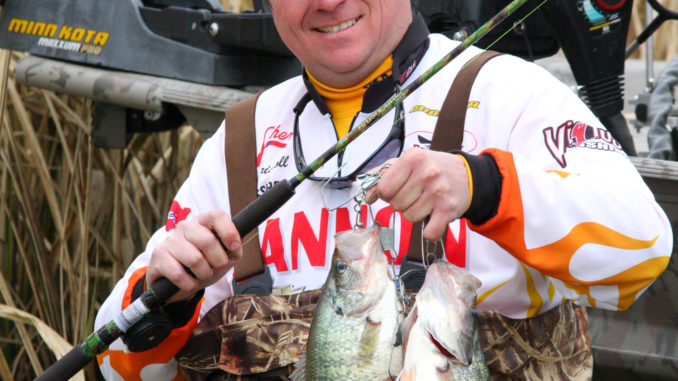
Coastal Louisiana anglers are no strangers to wade fishing for speckled trout, but there’s a different kind of “speck” that folks are starting to realize bite just a little bit better when the water isn’t slapping the sides of their boats. Sac-a-lait, crappie, white perch – whatever you want to call them – spawn in thick, shallow-water cover during the spring, and the only way to get to them is with your feet.
I was introduced to wade fishing for crappie recently when Kent Driscoll, a representative of BnM Poles, donned his waders and jumped out of his specialized War Eagle crappie boat while we were fishing an oxbow off the Mississippi River.
On his way out, he grabbed a single pole, a pocket full of Roadrunner jigheads in red, orange and chartreuse, and a pack of 2-inch Southern Pro chartreuse/orange, chartreuse/black and chartreuse/red Glow Tubes.
He already had a jar of Berkley Crappie Nibbles in his pocket, and he busily threaded one onto the hook of his jighead before the ripples of his entry disappeared. Rather than head out to what would have been the easiest water to wade, Driscoll turned and headed straight for the thickest cover.
“A lot of people are starting to realize that wade fishing allows them to quietly target shallow, spawning crappie that are hard for boat anglers to access,” Driscoll explained as he poked the bottom in front of him with a makeshift wading stick. “If your lake has heavy cover like reeds, weeds, brush, trees, bushes, rocks – anything that crappie will move into to spawn – you ought to give wading a try.”
Driscoll continued to push forward with scarcely a ripple behind him. As he started dropping his jig around some flooded reeds, he explained that he always tries to move as silently as possible while working into the wind so as not to spook the fish. Neither the reeds nor the low-hanging cypress limbs were a match for Driscoll as he expertly maneuvered his long pole around it all.
“You’ve got to use a shorter rod,” he insisted. “I like the camouflage BnM BrushCutter, and I recommend anywhere from 8 to 10 feet. The shorter rods are easier to control in the heavy cover, and a rod like the BrushCutter is designed to fish heavy cover and ‘airmail’ crappie out of the thickest vegetation. You don’t want to mess around battling a crappie with a really limber rod around all this thick stuff.”
Driscoll began adding crappie to his old, metal safety-pin stringer as he carefully worked along the inside of the reeds. No opening, no matter how small and insignificant, escaped without his dropping a jig into it. He paid particular attention to any little brushy twigs sticking above the water, as he said they often indicate a larger pile underneath. Cypress knees were also frequently targeted.
“It’s just a killer way to catch crappie when they’re up spawning,” Driscoll concluded. “If you’re getting tired of looking at all that water that you can’t get up into and fish, take a pair of waders with you next time you head out. Get in the water, and get back there where the fish are. You’ll be surprised at how many bites you’ve been passing by.”


